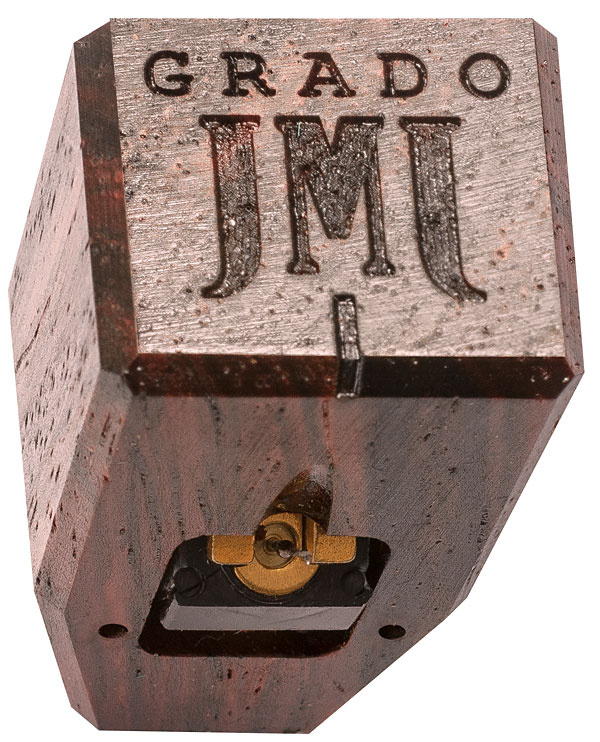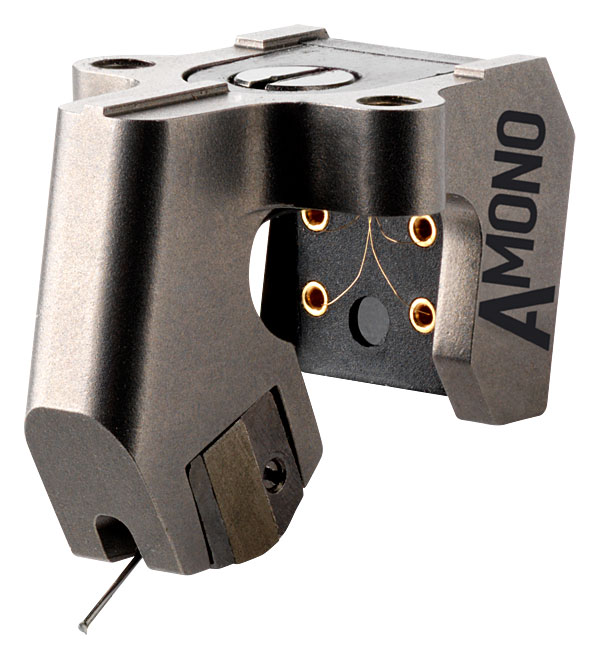| Columns Retired Columns & Blogs |
This provides some perspective for my own modest mono adventure.
Vocal sibilants have time now, beyond the initial, cleanly drawn transient, to expand and better capture the event, which helps produce a more convincing and lifelike presentation. I'm listening now to Lee Morgan's trumpet on Tina Brooks's Minor Move (Blue Note Tone Poet series B0030487-01); following each trumpet transient blast is an expansive "opening" that was previously shortchanged.
It's not as if Lyra backed off anything here. The top end isn't "burnished" or softened. The original Atlas's transient precision has not been blunted. Rather, the change added a few things that were missing or shortchanged on an already great-sounding cartridge. The price remains the same, at $11,995 for the standard Atlas λ and $12,995 for the lower-output SL version.
Here's the best news: Because the cartridge body itself is essentially unchanged, when you trade an Atlas in for a retip, you get the λ upgrade at no additional cost.

Grado Lineage Series Epoch3
In the December 2017 Analog Corner, I wrote about John Grado's Lineage Series Epoch moving-iron cartridge ($11,999, footnote 3). The Epoch embodied Grado design principles but with new parts and more precision, including annealed, 24k solid gold wire finer than a human hair, "the best made Swiss-watch" tolerances, and, in a first for Grado, a new, specially designed diamond stylus mounted to a sapphire cantilever. Grado claimed for the new generator system "the lowest moving mass of any cartridge."
More recently, Grado backed up that claim by sending me a small plastic bag containing the "generator ring": the moving part in the Grado system. It is impossibly tiny.
The Epoch body is made of cocobolo wood, which, when struck, produces a clear, musical tone, which is why it's used to make musical instruments.
With its 1.0mV lowish output and required 47k ohm loading, you need a well-matched, low-noise MM phono preamp, though some users make do with an MC preamp loaded at 1000 ohms.
I raved about this cartridge's excellent measured channel separation (>30dB, with a 0.5dB channel balance), quiet groove tracing, and superior tracking (100µm peak lateral at 315Hz)—and its rich, smooth, non-mechanical sonics. "Your face just wants to lean into the picture and take it all in," I wrote. "Its overall musical balance is as knowing, sophisticated, and musically involving as any cartridge I've been lucky enough to audition."
Still, I figured that amplifying the Epoch with, say, the Audio Research Reference Phono 3 phono preamplifier would be way too rich for me. Given the option, I'd use the Epoch for classical and jazz and not for rock.
Mr. Grado must have heard similar thoughts from others. He produced an Epoch2 and sent me one. But before I could write about the 2—and before it went on sale—he sent me an Epoch3. He insists that this will be the last one.
In the press release that arrived (I swear) just as I finished writing this, Grado says the Epoch3 includes a newly developed four-step shielding technique that "allows for the isolation of the wire turns in the four coils," which "creates a cleaner signal path than any other phono cartridge currently in production."
I have no way of testing that claim, but no matter: The Epoch3 is similar in character to the original (and measures and tracks equally well), but it gets a better grip on everything, particularly in the bass and midbass, and is better focused. Faster, tighter, a bit leaner, with less "zaftig" bass, yet only marginally cooler, the Epoch3 will still thrill acoustic music fans, but those who also enjoy electrified instruments will feel less urge to swap cartridges when switching musical genres.
For a limited time, if you own an original Epoch in working condition, you can exchange it for a new Epoch3, factory-direct from Grado Labs.

Ortofon MC A Mono
I reviewed Ortofon's A95 stereo moving-coil cartridge in the May and June 2015 issues of Stereophile. The A95 replaced the A90 SLM stainless steel with SLM titanium, but in a similar-shaped body. The A95 used a less magnetic armature than the A90's highly magnetic, soft-iron one, bringing the A95 closer to the MC Anna's totally nonmagnetic armature and realizing the same benefits. Johannsen compensated for the lower output voltage by adding extra windings, producing an output voltage of 0.2mV—relatively close to the A90's 0.27mV. The A95 stereo was a more fully fleshed-out A90, with wider dynamics, especially in the bottom octaves, and a richer sound overall. It was like an A90 crossed with the original MC Anna. The result was a beautiful-sounding child.
The new MC A Mono ($4999, footnote 4)—that's what Ortofon calls it—is an A95 with the cross-coil armature rotated 45 degrees and wound only on the lateral axis so that it only reads horizontal (mono) groove modulations. It retains the stereo version's boron cantilever and Replicant 100 stylus profile. This approach is similar to that of Lyra on their more costly Atlas mono. Johannsen shows and explains his design at 1.48:50 on a YouTube video, shot at High End 2019 in Munich—URL in my report.
Here's where some mono "true believers" go ballistic. This cartridge breaks some rules. It doesn't have near-zero vertical compliance. It tracks too light, at 2.3 grams. Plus, in place of the typical 0.7mil spherical mono stylus, it has a Replicant 100. Heresy!
But not really. First of all, the vertical modulations that might be produced from warps or whatever don't result in any output. Second, the Replicant stylus gets down deeper in the groove, where it's likely to encounter heretofore untouched, unworn groove walls. The stylus will not "bottom out" or "rattle around"!
To test that theory, I used it to play my original copy of June Christy's simmering, salacious Something Cool (Capitol T516), which suffers from some "wear crackle." With the MC A Mono, I still heard a few pops and ticks, but the "wear crackle" was gone. Not just diminished: gone.
The stereo A95's smooth, even, spectrally balanced persona was also evident here. Standing behind that was the stability and black backdrop that only a true mono cartridge can provide.
Next, I went to Surf Ride (Savoy MG12089) featuring Art Pepper and "his groups," issued in 1956 but compiled from earlier sessions. This speedy, Charlie Parker–influenced, early Art set produced smooth, detailed, edgy excitement—somewhat faster and more detailed than I was used to with the Miyajima mono family's more "old school" spherical stylus and its "nostalgic" sound.
To check a modern mono reissue, I put on Speakers Corner's reissue of Milt Jackson's Ballads & Blues, originally issued on Atlantic Records in 1956 (Atlantic/Speakers Corner 1242). Kevin Gray cut lacquers from the original master tape (using a stereo cutting stylus). Speakers Corner has released many Gray-cut LPs over the years, though they are not promoted as such. I really should compile a list!
"How High the Moon," side two's opening track, features Kenny Clarke on drums, Lucky Thompson on tenor sax, John Lewis on piano, "Skeeter" Best on guitar, and Oscar Pettiford on bass. The bass energy on this track sounded muscular and intense. The MC A Mono locked it in tight with a nimble attack followed by solid, tuneful, well-controlled sustain that was free of bloat. Jackson's vibes had an addictive, solid ring. The stable mono image hung between the speakers, large, three-dimensional, and well-focused. The picture was smooth, full-bodied, well-detailed, and powerful.
Reproducing Schubert's Sonatinas Nos.1 and 2, Op.137, performed by Johanna Martzy and Jean Antonietti (UK Columbia/Electric Recording Company 33CX 1359/ERC018), the MC A Mono produced a solid violin image with startling immediacy and silky string sheen, with the piano placed well behind and somewhat swallowed (appropriately) by room sound. I don't see how even the most confirmed SPU guy or gal wouldn't enjoy this cartridge's presentation of this all-tube record cut using a mono cutter head.
The Ortofon MC A Mono is not for the softness-and-warmth nostalgia crowd, and it definitely produces a more intense and forward picture (though neither cool nor bright) than the Miyajimas, or the Grado Epoch mono for that matter. It's one to consider if mono rock albums are in your mix, but not if you want more romance—in your phono cartridge, that is: Your life is your own business.
There's something for everyone in the mono-cartridge mix. Add the MC A Mono to the group at the top—at least in my mono-cartridge experience.
Footnote 4: Ortofon A/S, Stavangervej 9 DK-4900, Nakskov, Denmark CVR 17015028. Web: ortofon.com. US distributor: Ortofon USA, 500 Executive Blvd. Suite 102, Ossining, NY 10562.

It's so rare that I get anything but bricks thrown at me under whatever I write that's published online here that I really do thank you!